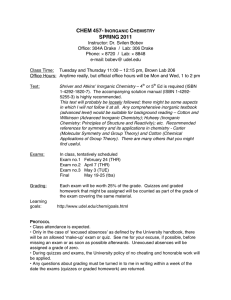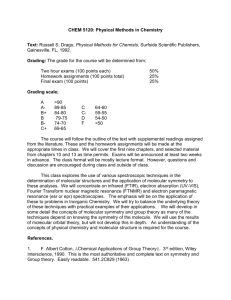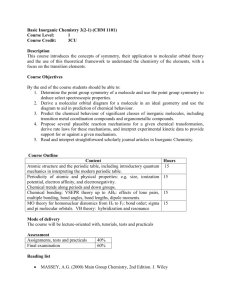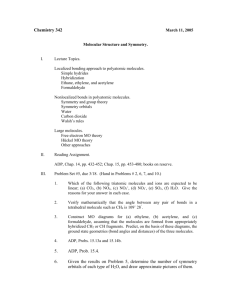CHEM.521 Inorganic Chem-I
advertisement
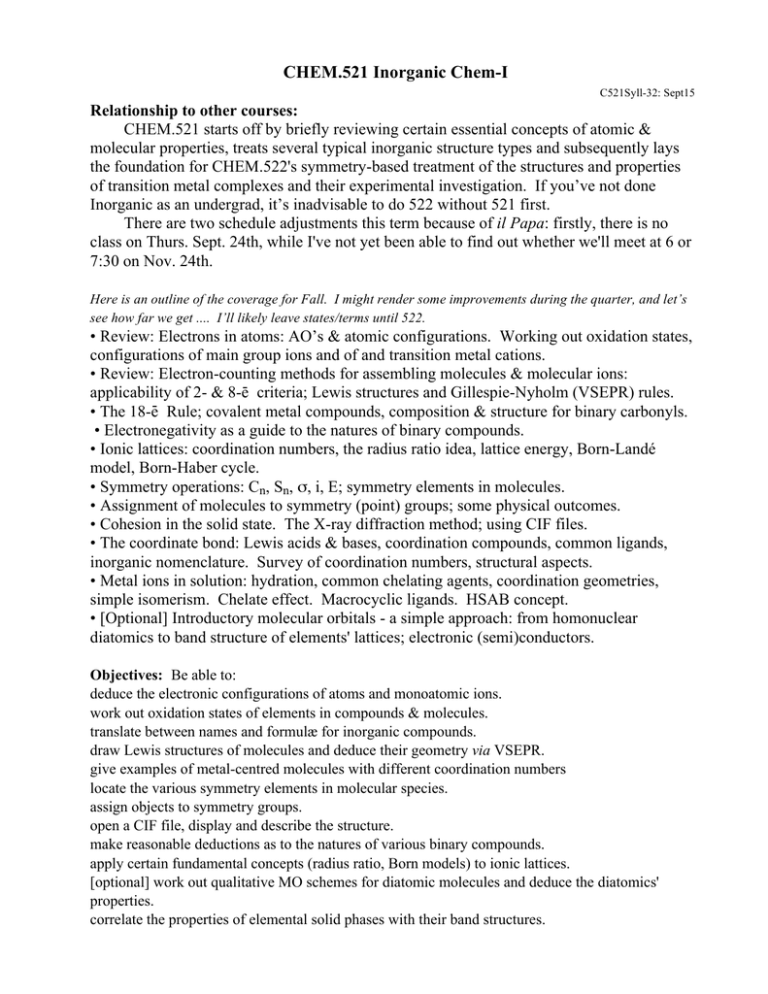
CHEM.521 Inorganic Chem-I C521Syll-32: Sept15 Relationship to other courses: CHEM.521 starts off by briefly reviewing certain essential concepts of atomic & molecular properties, treats several typical inorganic structure types and subsequently lays the foundation for CHEM.522's symmetry-based treatment of the structures and properties of transition metal complexes and their experimental investigation. If you’ve not done Inorganic as an undergrad, it’s inadvisable to do 522 without 521 first. There are two schedule adjustments this term because of il Papa: firstly, there is no class on Thurs. Sept. 24th, while I've not yet been able to find out whether we'll meet at 6 or 7:30 on Nov. 24th. Here is an outline of the coverage for Fall. I might render some improvements during the quarter, and let’s see how far we get .... I’ll likely leave states/terms until 522. • Review: Electrons in atoms: AO’s & atomic configurations. Working out oxidation states, configurations of main group ions and of and transition metal cations. • Review: Electron-counting methods for assembling molecules & molecular ions: applicability of 2- & 8-e- criteria; Lewis structures and Gillespie-Nyholm (VSEPR) rules. • The 18-e- Rule; covalent metal compounds, composition & structure for binary carbonyls. • Electronegativity as a guide to the natures of binary compounds. • Ionic lattices: coordination numbers, the radius ratio idea, lattice energy, Born-Landé model, Born-Haber cycle. • Symmetry operations: Cn, Sn, σ, i, E; symmetry elements in molecules. • Assignment of molecules to symmetry (point) groups; some physical outcomes. • Cohesion in the solid state. The X-ray diffraction method; using CIF files. • The coordinate bond: Lewis acids & bases, coordination compounds, common ligands, inorganic nomenclature. Survey of coordination numbers, structural aspects. • Metal ions in solution: hydration, common chelating agents, coordination geometries, simple isomerism. Chelate effect. Macrocyclic ligands. HSAB concept. • [Optional] Introductory molecular orbitals - a simple approach: from homonuclear diatomics to band structure of elements' lattices; electronic (semi)conductors. Objectives: Be able to: deduce the electronic configurations of atoms and monoatomic ions. work out oxidation states of elements in compounds & molecules. translate between names and formulæ for inorganic compounds. draw Lewis structures of molecules and deduce their geometry via VSEPR. give examples of metal-centred molecules with different coordination numbers locate the various symmetry elements in molecular species. assign objects to symmetry groups. open a CIF file, display and describe the structure. make reasonable deductions as to the natures of various binary compounds. apply certain fundamental concepts (radius ratio, Born models) to ionic lattices. [optional] work out qualitative MO schemes for diatomic molecules and deduce the diatomics' properties. correlate the properties of elemental solid phases with their band structures. be able to visually dissect coordination complexes into correctly charged ligands and metal. recognize Lewis acids and bases as parts of coordination complexes. recognize and know examples of different kinds of ligands. apply certain criteria for deducing outcomes of the competition between ligands for metals. Text: • The course notes will get posted. • A. Vincent’s “Molecular Symmetry & Group Theory” is a very useful little text. • Kettle’s Symmetry in Chemistry materials are now available on the web, at: http://www.rsc.org/Membership/Networking/InterestGroups/EducationalTechniques/Chemi stryCassettes/index.asp General inorganic texts, upon which I do not rely heavily, but are useful, are: • Atkins et al., "Shriver & Atkins' Inorganic Chemistry" (Freeman) • Housecroft & Sharpe: Inorganic Chemistry (Prentice-Hall) • Miessler & Tarr: Inorganic Chemistry (This one is quite readable, but more limited in coverage) If you are taking the 521-22-23 sequence, I suggest buying one. • Molecular models are quite useful: Darling Models are good value. Some handy websites: 1) Periodic Tables: http://www.ptable.com/ http://www.webelements.com/ http://www.rsc.org/periodic-table http://www.youtube.com/watch?v=AcS3NOQnsQM&feature=related 2) The Orbitron at Sheffield: http://shef.ac.uk/chemistry/orbitron/index.html 3) Tutorial on molecular symmetry: http://symmetry.otterbein.edu/tutorial/index.html 4) Symmetry properties of several virtual models: http://symmetry.otterbein.edu/gallery/index.html 5) Chapter on X-ray diffraction: http://www.doitpoms.ac.uk/tlplib/xray-diffraction/index.php One of several learning modules for materials science, including Raman spectroscopy, ferromagnetism and Pourbaix diagrams. 6) XRD interactive demo for extinction/reinforcement with variation of angle, wavelength, etc: http://www-outreach.phy.cam.ac.uk/camphy/xraydiffraction/xraydiffraction_exp.htm Other stuff: Work on the problem sets as soon as we have covered the material in class !! If you do not do the homework, you will find it hard to pass the exams, and virtually impossible to get a good grade. Answers are provided for some homework problems, while others require a descriptive/written answer. You are encouraged to discuss these with me at our mutual convenience, and people who take the trouble to do so do better in the course. Your grade is based on a graded homework set (15%) plus the (usually three) exams: two midterms (15%, 25%) plus a final exam (45%). The grade ranges are: D= 43-45; D+=46-49; C–=50-53; C=54-56; C+=57-59; B–=60-64; B= 65-69; B+=70-75; A–=76-83; A=84-91; A+=92-100. You may bring our periodic table and a molecular model kit to the exams (some of the assigned classrooms have no periodic table). If you are not officially registered in the course, no midterms or quizzes will be graded or returned, and you may not receive the distributed materials. Tentative mid-term dates are Oct. 13th & Nov. 10th. Penalizable spelling/terminology errors on exams/homework: "flourine", "valance", “pyrimidal”, “planer” (for 'planar'). Missed an Exam ? You can make up one missed exam. You don't need an excuse to take the make-up exam if you miss a midterm or the final, but you must then attend the make-up at the ultimately designated time and place or take a zero on it. Make-up exams are tentatively scheduled for the afternoon of Monday, Dec. 14th. The 15-Minute Rule: If I'm more than 15 minutes late and do not send word of what’s happening, consider the class cancelled. Some University Policies we are asked to remind you about: Academic integrity: http://www.drexel.edu/provost/policies/academic_dishonesty.asp Disability accommodations: http://www.drexel.edu/oed/disabilityResources/students/ Dropping courses: http://www.drexel.edu/provost/policies/course_drop.asp Financial Obligation: http://drexel.edu/drexelcentral/billing/billing/policies/ Email is a good way to get in contact with me - e.g., to make an appointment to discuss course material or homework problems. Prof. Addison 12-418 AddisonA@drexel.edu 215-895-2646
